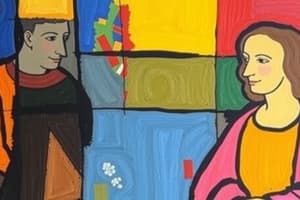Podcast
Questions and Answers
Nicolaus Copernicus proposed a geocentric model of the universe.
Nicolaus Copernicus proposed a geocentric model of the universe.
False (B)
Raphael was a sculptor, painter, and architect, famous for the ceiling of the Sistine Chapel.
Raphael was a sculptor, painter, and architect, famous for the ceiling of the Sistine Chapel.
False (B)
The Medici family ruled Rome, patronizing the arts and fostering a cultural revival.
The Medici family ruled Rome, patronizing the arts and fostering a cultural revival.
False (B)
Raphael was a sculptor, painter, and architect, famous for the ceiling of the Sistine Chapel.
Raphael was a sculptor, painter, and architect, famous for the ceiling of the Sistine Chapel.
The Renaissance saw a decline in the power of city-states like Florence and Venice.
The Renaissance saw a decline in the power of city-states like Florence and Venice.
Renaissance Neoplatonism emphasized the limitations of human potential.
Renaissance Neoplatonism emphasized the limitations of human potential.
Leonardo da Vinci was a polymath, known for his innovative designs and inventions in science and engineering.
Leonardo da Vinci was a polymath, known for his innovative designs and inventions in science and engineering.
The Medici family sponsored famous artists, including Galileo Galilei and Johannes Kepler.
The Medici family sponsored famous artists, including Galileo Galilei and Johannes Kepler.
Luca Pacioli and Niccolò Tartaglia contributed to the development of astronomy.
Luca Pacioli and Niccolò Tartaglia contributed to the development of astronomy.
Florence was a hub for artistic, scientific, and cultural innovation during the Renaissance.
Florence was a hub for artistic, scientific, and cultural innovation during the Renaissance.
Flashcards are hidden until you start studying
Study Notes
Scientific Discoveries
- Revolution in Astronomy: Nicolaus Copernicus proposes a heliocentric model, challenging geocentric views.
- Anatomical Studies: Andreas Vesalius publishes "De humani corporis fabrica", a foundational work on human anatomy.
- Mathematical Advancements: Luca Pacioli and Niccolò Tartaglia contribute to the development of mathematics, including the concept of zero.
Art and Architecture
- Renaissance Humanism: Art and architecture focused on human proportions, classical styles, and realistic representations.
- Famous Artists:
- Leonardo da Vinci: Polymath and artist, known for the Mona Lisa and The Last Supper.
- Michelangelo: Sculptor, painter, and architect, famous for the ceiling of the Sistine Chapel.
- Raphael: Painter and architect, known for his frescoes in the Vatican.
- Architectural Innovations:
- Use of perspective and proportion in building design.
- Development of the Renaissance arch, dome, and column.
Literary Movements
- Humanism: Focus on classical texts, individualism, and human potential.
- Renaissance Neoplatonism: Revival of Plato's philosophies, emphasizing the potential for human beings to achieve divine-like status.
Politics and Monarchies
- City-States: Independent city-states like Florence, Venice, and Milan emerged as powerful entities.
- Monarchical Power: Kingdoms like France, Spain, and England consolidated power, leading to the rise of absolute monarchies.
- Medici Family: Ruled Florence, patronizing the arts and fostering a cultural revival.
Cultural Revival
- Classical Influences: Revival of interest in classical Greek and Roman culture, art, and literature.
- Urbanization: Growth of cities, leading to increased cultural exchange and intellectual pursuits.
Florence
- Birthplace of the Renaissance: Florence was a hub for artistic, scientific, and cultural innovation.
- Medici Family: Ruled Florence, fostering a cultural revival through patronage of the arts.
Medici Family
- Rulers of Florence: The Medici family ruled Florence, promoting the arts, science, and culture.
- Patronage: The Medici family sponsored famous artists, including Leonardo da Vinci, Michelangelo, and Raphael.
Leonardo da Vinci
- Polymath: Artist, inventor, engineer, and scientist, known for his innovative designs and inventions.
- Famous Works: Mona Lisa, The Last Supper, and Vitruvian Man.
Raphael
- Painter and Architect: Known for his frescoes in the Vatican, including The School of Athens.
- Innovative Style: Developed a unique style blending classical and Renaissance elements.
Michelangelo
- Sculptor, Painter, and Architect: Famous for the ceiling of the Sistine Chapel and his sculptures, such as David.
- Innovative Techniques: Developed new techniques in sculpture and painting, pushing the boundaries of Renaissance art.
Studying That Suits You
Use AI to generate personalized quizzes and flashcards to suit your learning preferences.




